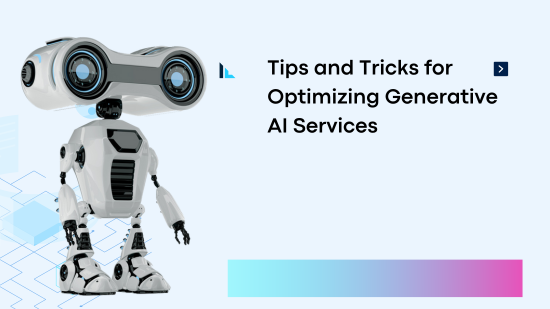.png)
Introduction
Generative AI services are revolutionizing industries by enabling the creation of new and innovative content. These services can generate text, images, music, and even videos, offering immense possibilities across various sectors such as entertainment, healthcare, and finance. Optimizing Generative AI services is crucial to ensure they deliver accurate and high-quality outputs, maximally leveraging their capabilities. In this blog post, we will delve into the significance of optimizing generative AI services and offer practical tips and tricks to enhance their performance.
Understanding Generative AI Services
What Are Generative AI Services?
Generative AI services are a branch of artificial intelligence focused on generating new content. Unlike traditional AI, which performs tasks based on predefined rules, generative AI creates novel data that resembles human-created content. This aspect makes it particularly valuable in fields requiring creative thinking and innovation. For instance, Generative AI Development Services can be utilized to autonomously compose music, create paintings, and develop compelling narratives.
Different Types of Generative AI Services
Generative AI services span a wide array of applications, including:
- Image Generation: Using Generative Adversarial Networks (GANs) to create realistic images.
- Text Generation: Language models such as GPT-3 can generate human-like text, making it valuable for content creation and customer service.
- Music Composition: Generative AI can produce original music compositions across various styles and genres.
- Video Synthesis: AI-powered systems can generate lifelike videos, including deepfakes, which have ethical considerations.
- Synthetic Data Generation: Useful for data augmentation, especially in scenarios where real-world data is scarce or expensive to collect.
Industries Using Generative AI Services
Many industries have incorporated Generative AI Development Company to push the boundaries of innovation. Some notable examples include:
- Entertainment: Personalized content creation for immersive and interactive user experiences.
- Healthcare: Generating synthetic medical images to improve diagnostic accuracy.
- Architecture and Interior Design: Creating virtual models and spaces for better visualization and planning.
- Video Game Development: Generating realistic characters and environments to enhance gaming experiences.
Tips for Optimizing Generative AI Services
Importance of Data Quality and Quantity
The performance of generative AI models significantly depends on the quality and quantity of data. High-quality, diverse datasets ensure that models learn effectively and generalize well to new data. Therefore, investing time in curating comprehensive datasets is essential for the success of Generative AI Development Services.
Utilizing Pre-trained Models for Faster Results
Pre-trained models serve as a strong foundation for building specialized applications. They save time and computational resources by leveraging existing knowledge. By fine-tuning pre-trained models on domain-specific data, Generative AI Development can be accelerated significantly.
Fine-tuning Models for Specific Tasks
Fine-tuning involves adapting pre-trained models to specific tasks by training them further on domain-focused datasets. This process ensures that the models perform optimally within the desired context, enhancing the efficacy of Generative AI Solutions for targeted applications.
Regularly Updating Models with New Data
As user preferences and trends evolve, continuously updating models with new data is vital for keeping them relevant and accurate. Regular updates help models adapt to changes in the input data distribution, improving their performance and ensuring sustained utility.
Monitoring and Evaluating Model Performance
Ongoing monitoring and evaluation are critical to track the performance of generative models. Implementing performance metrics and regular assessments helps identify areas for improvement, ensuring that the Generative AI Development Company can make data-driven decisions to enhance model efficiency and effectiveness.
Tricks for Enhancing Generative AI Services
Using Data Augmentation Techniques
Data augmentation techniques involve creating synthetic data by modifying existing data samples. This approach can significantly improve model performance by increasing the diversity of the training dataset. Techniques such as rotation, flipping, and noise addition can help models generalize better.
Implementing Ensemble Methods
Ensemble methods combine multiple models to improve prediction accuracy and robustness. By leveraging the strengths of various models, ensemble methods can produce more reliable and accurate outputs. This trick is particularly useful for enhancing the performance of Generative AI Solutions.
Leveraging Transfer Learning
Transfer learning enables the reuse of models trained on one task for a different but related task. This technique speeds up the training process and improves model performance, making it an effective strategy for optimizing Generative AI Development Services.
Exploring Different Architectures
Experimenting with different model architectures can lead to better performance. For instance, exploring variations of GANs or transformer models can provide insights into the most suitable architecture for a specific application, enhancing the overall output quality.
Collaborating with Domain Experts
Collaboration with domain experts can provide valuable insights and domain-specific knowledge, which is essential for fine-tuning models. Domain experts can help identify relevant data, interpret model outputs, and suggest improvements, ensuring that Generative AI Development aligns with industry standards and expectations.
Conclusion
In conclusion, optimizing Generative AI services is paramount for unlocking their full potential and delivering high-quality outputs. By focusing on data quality, utilizing pre-trained models, fine-tuning for specific tasks, regularly updating models, and monitoring performance, organizations can significantly enhance the efficiency of their generative AI applications. Additionally, leveraging data augmentation, ensemble methods, transfer learning, exploring different architectures, and collaborating with domain experts are crucial tricks for further improving generative AI services. By implementing these tips and tricks, businesses can ensure that their Generative AI Development Company remains at the forefront of innovation and creativity, delivering cutting-edge solutions to meet the ever-evolving demands of various industries.